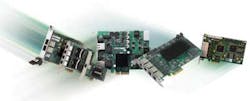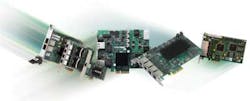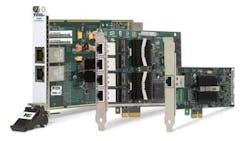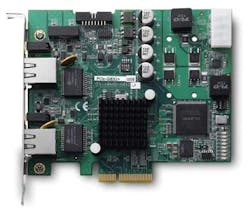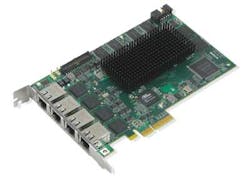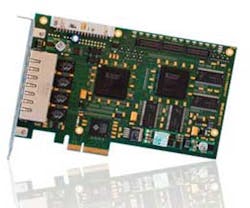GigE Vision Headed Faster
Andrew Wilson, Editor
Since its inception five years ago, the GigE Vision standard has become one of the most popular camera interface standards, with hundreds of cameras being offered by numerous vendors worldwide.
After release of Version 1.0 in 2006, the standard has had two minor revisions. Version 1.1 included new pixel formats and Bayer packed format support, autodetection of link speed, and enhanced support for the GenICam and GenApi standards, whereas Version 1.2 added control and support for nonstreamed devices, allowing peripherals such as lighting to be controlled across the GigE Vision network.
Major revisions
Now, a major revision of the specification is underway that George Chamberlain, president of Pleora Technologies, says is scheduled for final release in the second half of 2011. According to Chamberlain, Version 2.0 of the GigE Vision standard will encompass a host of additional features—higher data rates, clock synchronization, image compression, improved flow control, and frame packing, for example.
Although the current version of the standard allows for limited data rates to be transferred from cameras to a host computer, Version 2.0 will formally introduce 10 Gbits/s as part of the standard and, in doing so, will likely accelerate the market’s adoption of 10 Gigabit Ethernet (10GigE) interfaces. In addition, this may result in a market push for vendors to add faster 10GigE physical transceivers (PHYs) and media access controllers (MACs) to their cameras and frame grabbers.
However, in addition to 10GigE, Version 2.0 will support link aggregation. Though in theory faster data rates can be achieved by implementing the IEEE 802.1AX link aggregation protocol, in practice aggregation can be limited in some scenarios due to footprint and/or cabling impracticalities. Dual aggregation is certainly feasible, but it’s unlikely we’ll see demand for more than two GigE connectors on one transmitter.
Higher speed
At VISION 2009, Allied Vision Technologies introduced four GigE cameras: the Prosilica GX1050, a 1-Mpixel camera that runs at 120 frames/s; the GX1660 and GX1910 that incorporate a 2-Mpixel CCD running at 60 frames/s; and the GX3300 with an 8-Mpixel imager running at 15 frames/s.
With output data rates far exceeding the 1-Gbit/s maximum throughput of the GigE Vision standard, these cameras were equipped with two GigE ports and use the link aggregation standard defined in IEEE standard 802.3ad to combine both physical GigE links into a single logical link (see “Gigabit Ethernet cameras go on show at VISION,” Vision Systems Design, December 2009).
To demonstrate the capability of 10GigE, Pleora Technologies recently showed how its next-generation interface products could be used in GigE-based systems. In the first, a CleverDragon Camera Link Medium camera from Toshiba Teli was interfaced to Pleora’s yet-to-be-released iPORT CL-Ten IP engine. In operation, 2.6-Gbit/s Camera Link data from the camera was transferred to the iPORT CL-Ten, adapted to GigE Vision, and transmitted over a 10GigE interface to a host PC. Using a 10GigE PCI Express network interface card (NIC) from Intel, the data were then transferred to the host memory of the PC and displayed.
In the second demonstration, the company showed how data from three nonstandard-format 5-Mpixel cameras from Framos running at 25 frames/s were reformatted using Pleora’s iPORT NTx-Ten IP engine and transferred to the PC over the GigE Vision interface. Both demonstrations were shown at VISION 2010; videos can be seen at http://bcove.me/o3w1azl5.
Compression and control
While supporting 10 Gbits/s is impressive, it is just one of many additions to the proposed Version 2.0 of the standard.
“Although it is possible to transmit compressed video over GigE Vision,” says Chamberlain, “no standard yet exists to guarantee interoperability between disparate cameras and computers.”
To ensure this interoperability, Version 2.0 will support compression standards based on the JPEG, JPEG 2000, and H.264 standards and specify how the compressed data are transmitted and recognized over the network. The IEEE 1588 standard, a precision clock-synchronization protocol for networked measurement and control systems, will also be incorporated into Version 2.0 of the GigE Vision standard.
According to Chamberlain, with expert implementation, this can reduce the networking triggering latency to 150 µs and jitter to sub-microsecond levels. Two other features also slated for Version 2.0 of the GigE Vision standard will include improved flow control and frame packing.
Flow control, as defined in the IEEE 802.3 standard, is a method of throttling data across the network should a camera or computer be overwhelmed with data. In such a scenario, a PAUSE frame is transmitted across the network that stops the transmission of the sender or receiver for a specific period of time. Incorporating this function into Version 2.0 of the GigE Vision standard will ensure image data evenly flow across the network.
For cameras that transmit small images at high data rates, frame packing will reduce the overhead of data transmission. While the former GigE Vision image payload type would have required three packets, Version 2.0 will require only a single packet.
Interface boards
Indeed, 10GigE will provide much of the bandwidth required by the latest high-speed linescan and area-array cameras, but it remains to be seen how current vendors of PC add-in GigE Vision interface boards will tailor their product portfolios.
To that point, with many system developers using off-the-shelf NICs from Intel for GigE, only a handful of companies currently offer GigE Vision add-in interface boards. In a white paper recently published by DALSA, R&D director Eric Carey showed how gigabit speed can be achieved using a standard NIC (see “Exposing jitter and latency myths in Camera Link and GigE Vision systems,” Vision Systems Design, January 2011). “Those NICs are much cheaper than a frame grabber (by a factor between 5 and 10) and many times are even included on the PC motherboard,” says Carey, “so it is hard to understand why a plain frame grabber would be successful.”
“Using a GigE frame grabber rather than an integrated or additional NIC increases the cost of a system,” says Michael Noffz, head of marketing at Silicon Software. “Most customers use the integrated NIC in the PC for single-camera systems, or a NIC board for dual-camera systems. However, if a greater number of cameras are used, a greater load is placed on the CPU, requiring decided hardware.”
To compete with single-port off-the-shelf products developed for the computer networking market, many GigE frame grabber vendors offer additional features such as multiport interface capability, optional I/O trigger capability, link aggregation, and on-board processing.
National Instruments’ NI-8231/8234/8235 Series of Gigabit Ethernet PCI Express add-in cards offers system developers a choice of one, two, or four GigE ports (see Fig. 1). In the design of these boards, NI has used Intel’s 82572EI Gigabit Ethernet controller IC that features an integrated Gigabit Ethernet MAC and PCI Express interface.
“NI image-acquisition boards include NI’s high-performance driver NI-IMAQdx that is optimized for a specific chipset and results in better CPU performance than a universal filter driver,” claims Kamalina Srikant, product marketing engineer for machine-vision hardware and software at NI. Although there is no I/O capability on NI’s boards, when cameras based on the GigE Vision 2.0 standard are available, it will be possible use NI’s 1588 timing and synchronization software for this purpose.
Although the GIE62+ two-port GigE interface board from Adlink Technology features similar hardware capability, the company has also chosen to add Power over Ethernet (PoE) capability to the board (see Fig. 2) Thus, PoE-based GigE cameras can be supported without the need to use separate PoE injectors such as the VXPI100 from Versa Technology.
In machine-vision applications where on-board processing and external triggering requirements may be required, the Solios GigE Ethernet four-port NIC PCI Express card from Matrox Imaging also offers built-in I/O ports for triggering cameras externally, activating strobe lights, and tracking movement from rotary encoders (see Fig. 3). The company also offers a version of the board with an optional Altera Stratix FPGA that can be used to offload image-processing functions from the host CPU.
Like Matrox, Silicon Software has also recognized the need to reduce CPU overhead in GigE Vision-based systems. The company’s microEnable IV VQ4-GE (see. Fig. 4), a four-port PCI Express card, restores a complete image from GigE Vision data packets and transfers it to the host, minimizing the interrupt load on the host CPU.
“Using the frame grabber, additional image-preprocessing functions such as Bayer color reconstruction can also be offloaded from the CPU,” says Noffz. Later this year, the company expects to add both PoE and link aggregation to the next revision of the board, once Version 2.0 of the GigE Vision standard is finalized.
Currently, add-in frame grabber boards are only offered by a few vendors; however, this may change with the latest introduction of the GigE Vision standard. “Processing data in real time from a Camera Link Full interface at up to 850-Mbyte/s speeds—a bandwidth similar to 10GigE—is a difficult task,” says DALSA’s Carey “In many situations, this requires splitting data across multiple PCs, and having on-board processing capability on a vision processor is an elegant way to deal with these high bandwidths.”
With good software drivers, today’s PCs can certainly handle 10GigE, but the introduction of Version 2.0 of the GigE Vision standard could result in many more vendors producing interface cards that offer both on-board processing and 10GigE interfaces.
Company Info
Adlink Technology Taipei, Taiwan www.adlinktech.com
Allied Vision Technologies Stadtroda, Germany www.alliedvisiontec.com
Altera San Jose, CA, USA www.altera.com
DALSA Waterloo, ON, Canada www.dalsa.com
Framos Pullach, Germany www.framos.eu
Matrox Imaging Dorval, QC, Canada www.matrox.com/imaging
National Instruments Austin, TX, USA www.ni.com
Pleora Technologies Kanata, ON, Canada www.pleora.com
Silicon Software Mannheim, Germany www.silicon-software.com
Toshiba Teli Tokyo, Japan www.toshiba-teli.co.jp
Versa Technology Chino, CA, USA www.versatek.com
